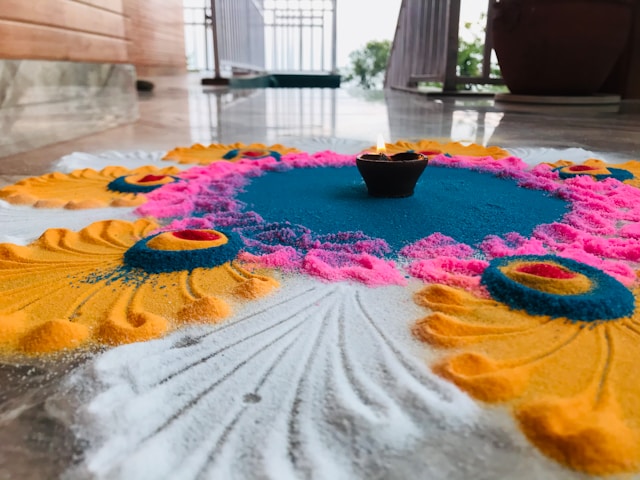Rangolis have been a staple of cultures throughout India since time immemorial. These decorative items are typically made out of materials like ground rice, flower petals, colored rocks and powdered quartz and represent positivity, love and other positive things.
The uses of rangolis are manifold. While they’re a household staple during cultural events like Diwali, many Indians also keep a few of these decorations outside their doorsteps all year round to welcome positivity into their homes. While many rangolis are patterned after flowers, you can take inspiration elsewhere when designing your own.
Rangolis are typically made at home and by hand, so whether you’ve been making rangolis for years or are just getting into the tradition, the process is a fantastic way to express your creativity and connect with your culture. Keep reading to learn how to master rangoli design for prosperity and positivity.
Use Digital Tools to Help
When decorating your home for events like Diwali or Onam or simply looking to create décor for everyday use, utilising digital tools can help spur your creativity and come up with designs in record time.
For instance, you can use a banner template to create attractive home decorations during the holidays. If you’re specifically looking to make rangolis, software like Adobe Express and Canva can help you design prototypes that you can later refer to when creating your physical artwork.
If you want to go a step further, you can also use augmented reality tools like Houzz to help you visualise how specific rangoli designs would look in your house or on your doorstep. After all, designing beautiful rangolis is one thing, but ensuring that they synergise with the rest of your décor is another.
Find Inspiration
Whether you’re designing rangolis for a special event or simply want to add a bit of good luck and positivity to your daily life, it’s important to find inspiration, especially if you’re going through a creative block. One way to do this is by browsing the Internet.
You’ll find loads of specialised rangoli designs for Diwali and other traditional festivals online. There are also many websites where you can find more general designs that can be used for any occasion. Social media platforms like Instagram and TikTok are another source of inspiration.
The Internet isn’t the only way to find rangoli designs you can use to fuel your own creativity. If you have friends who also participate in the tradition, you can also find inspiration by asking to see their work. You can even throw a rangoli-making party with friends and family to prepare for a festival.
Finding inspiration online or offline doesn’t mean simply copying someone else’s design. Browse through various rangoli designs, take note of different elements you like and incorporate them into your own unique rangolis. By combining existing art pieces with your own creative ideas, you can create decorations that truly stand out.
Use the Right Materials
When designing a rangoli, you should never underestimate the importance of choosing the right materials. Rangolis have been made for many generations all over India, so it’s no surprise that there are many different ways of making them. You can choose materials ranging from crepe paper to quartz powder.
When planning your designs, it’s vital to consider what art supplies are available near where you live and how well they’d go with each other. As mentioned earlier, digital prototyping can be incredibly helpful, as this practice reduces the likelihood of purchasing materials you later decide don’t work for what you had in mind.
Rangolis are supposed to create a joyous mood for guests entering your home, which is why many people work fresh flowers into their designs. If you have a garden, you can harvest a few flowers that you think would look beautiful in your rangolis.
Roses, marigolds and sunflowers all make for excellent choices due to their striking coloration. You’ll also be able to find these flowers at most flower shops, so if you don’t have a garden, simply head to your local florist. By using the best materials around, you can make your rangolis truly special.
Popular Styles and Regional Variations
Kolam
Kolam is a cherished tradition from South India, made using rice flour or colourful powders. You’ll often see it drawn outside front doors to welcome guests and invite good fortune.
With its flowing curves and geometric patterns built around a grid of dots, Kolam is all about balance and beauty. Artists typically use one continuous line to bring these elegant designs to life, and the results are captivating.
Mandana
In Rajasthan, Mandana brings a rustic charm to celebrations. Created using red clay and chalk, these designs draw on nature and folk art for inspiration – think birds, flowers, and traditional symbols.
Mandana patterns often feature strong outlines filled with contrasting colours, and they’re either drawn freehand or with stencils. This style is a staple during festivals and is closely tied to community and celebration.
Alpana
From Bengal comes Alpana, a style known for its delicate floral motifs and graceful curves. Typically made during weddings and religious occasions, Alpana uses a paste of rice flour and water to create detailed white-on-red designs that feel both sacred and celebratory.
Aipan
In the hills of Uttarakhand, Aipan stands out with its spiritual themes and symmetrical patterns. Using white rice paste, people create meaningful motifs tied to rituals and worship, often placing them on altars or doorsteps.
These designs are not only beautiful – they carry deep cultural and religious significance.
Let Your Personality Shine Through
Self-expression is the most important element of arts and crafts. While it’s all well and good to find inspiration elsewhere, your designs should ultimately be a reflection of your personality and artistic tastes.
Thankfully, there are countless directions you can go and elements you can tweak when designing rangolis. For one thing, you can mix and match colors. While it helps to refer to a color wheel and choose shades that complement each other visually, you should ultimately pick colors that mean something to you.
You can also customize the patterns of your rangolis to your tastes and the element of your culture you want to reflect. Rangolis are meant to represent joy and positivity, which is why many people create them in the shape of flowers. However, this isn’t a hard and fast rule: you can also design your rangolis in the likeness of deities, animals or even simple geometric shapes.
How to Put Your Rangoli Knowledge into Practice
Rangolis are a major part of cultures throughout India. These pieces of art represent light, positivity, happiness and other good things, so it’s no surprise that designing these decorative items is a staple among Indian households everywhere.
If you’re looking to bring some love and light into your home during a holiday or simply want to welcome some positive energy into your everyday life, designing rangolis can help. Follow the tips we’ve outlined in this article to create rangolis that are both beautiful and meaningful.
Photo by Siraj Alam on Unsplash (Free for commercial use)
Image published on November 14, 2020




